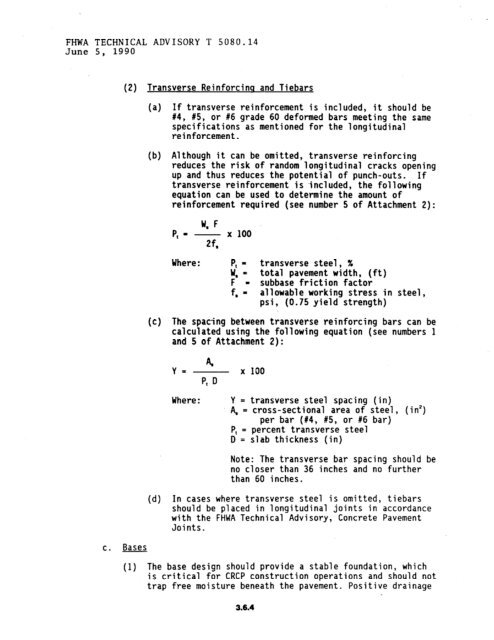chapter 3 rigid pavement - DOT On-Line Publications - Department ...
chapter 3 rigid pavement - DOT On-Line Publications - Department ...
chapter 3 rigid pavement - DOT On-Line Publications - Department ...
You also want an ePaper? Increase the reach of your titles
YUMPU automatically turns print PDFs into web optimized ePapers that Google loves.
FHWA TECHNICAL ADVISORY T 5080.14<br />
June 5, 1990<br />
C. Bases<br />
(2) Transverse Reinforcina and Tiebars<br />
(a) If transverse reinforcement is included, it should be<br />
#4, #5, or #6 grade 60 deformed bars meeting the same<br />
specifications as mentioned for the longitudinal<br />
reinforcement.<br />
(b) Although it can be omitted, transverse reinforcing<br />
reduces the risk of random longitudinal cracks opening<br />
up and thus reduces the potential of punch-outs. If<br />
transverse reinforcement is -included, the following<br />
equation can be used to determine the amount of<br />
reinforcement required (see number 5 of Attachment 2):<br />
4 F<br />
Pl - - x 100<br />
2fs<br />
Where: transverse steel, X<br />
= total <strong>pavement</strong> width, (ft)<br />
subbase friction factor<br />
allowable working stress in steel,<br />
psi, (0.75 yield strength)<br />
(c) The spacing between transverse reinforcing bars can be<br />
calculated using the following equation (see numbers 1<br />
and 5 of Attachment 2):<br />
9<br />
Y= x 100<br />
4 D<br />
Where: = transverse steel spacing (in)<br />
= cross-sectional area of steel, (in')<br />
per bar (#4, #5, or #6 bar)<br />
Pl = percent transverse steel<br />
D = slab thickness (in)<br />
Note: The transverse bar spacing should be<br />
no closer than 36 inches and no further<br />
than 60 inches.<br />
(d) In cases where transverse steel is omitted, tiebars<br />
should be placed in longitudinal joints in accordance<br />
with the FHWA Technical Advisory, Concrete Pavement<br />
Joints.<br />
(1) The base design should provide a stable foundation, which<br />
is critical for CRCP construction operations and should not<br />
trap free moisture beneath the <strong>pavement</strong>. Positive drainage<br />
3.6.4
















